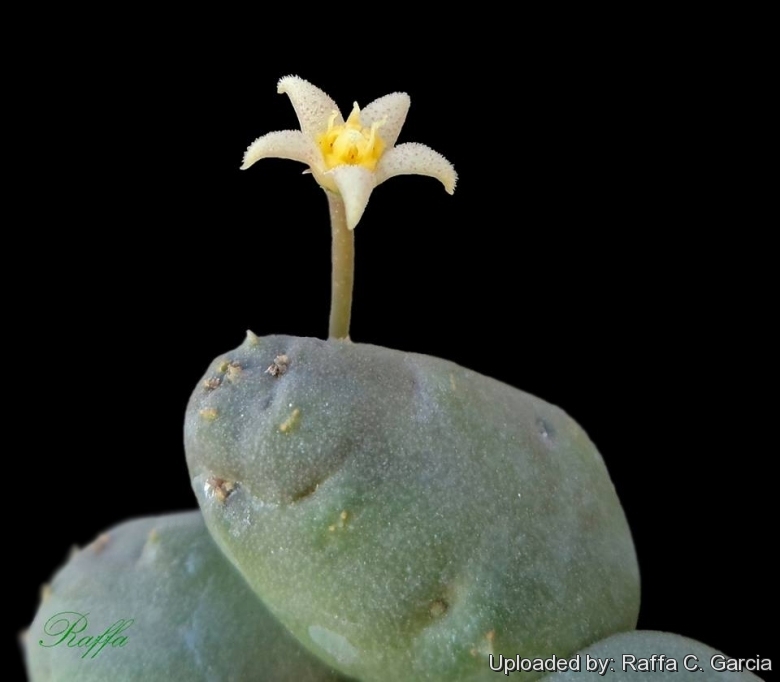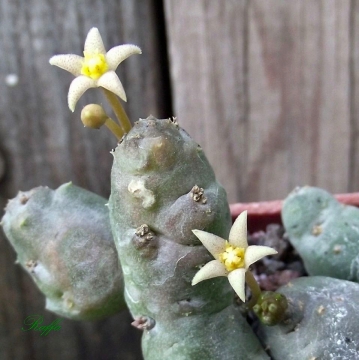




Your support is critical to our success.

Origin and Habitat: Piaranthus parvulusSN|32574]]SN|32574]]is is endemic to the Great and Little Karoo (Western Cape), South Africa.
Habitat and Ecology: It is a leafless succulents whose wrinkled, greyish stems grow typically among the weathered grey branches of dead shrubs often in association with Ruschia spp. (especially Ruschia spinosa) - semi-palatable ecological dominants and ideal associates for stick mimics. This habitat is shared with several leafless succulent plants such as Crassula lycopodioidesSN|26743]]SN|26743]], Euphorbia spp., and Orthonna protecta just a few of the more common. The population trend is stable.
Synonyms:
- Piaranthus parvulus N.E.Br.
AFRIKAANS (Afrikaans): Boesmanstoonjies, Boesmantoontjies
Description: Piaranthus parvulusSN|32574]]SN|32574]] is a clumping and prostrate species that spread over the ground forming cushions of small, jointed stems, these are reclining or upright, essentially subglobose, greyish-green, bluntly quadrangular, with 3 to 5 wart-shaped teeth on each edge. The flowers are uniformlv pale yellow or faintly lined with red-brown, 6-13 mm in diameter, with petals to 2 mm wide, the smallest in the genus. The inner corona lobes are adpresscd to backs of anthers at base only then erect.
Derivation of specific name: From Latin adjective 'parvulus', small, minute; for the small flowers.
Stems: Decumbent or ascending, 1.5-5 (-9) cm long, 1-2 cm, thick, oblong or subglobose (ovoid), obtusely 4-angled, with 3–5 tubercle-like apiculate teeth 1.5-3 mm long along each angle, greyish-green or perhaps slightly glaucous (sometimes dull light green under cultivation), tinged or mottled with purple.
Inflorescences: Flowers appear in multi-flowered inflorescences (1 to 12), but seldom more than 2 or 3 open together in the same fascicle, often 2–3 fascicles to a stem, at the middle or top. Pedicels erect, 4-25 mm long, rather slender, glabrous.
Flowers: Somewhat valerian-scented. Sepals 1-2 mm long, lanceolate, acute, glabrous. Corolla rotate, without a distinct tube, 6-13 mm in diameter. Corolla-lobes free, usually ascending (at an angle of 15 - 40°), 2-5 mm long, 2-2.5 mm broad at the base, deltoid-lanceolate, with acute recurved tips, bright yellow to straw-yellow, without spots, glabrous on the back, densely hairy on the inner face and not ciliate. Hairs 0.05-0.2 mm long, conical, white. Corona 2-3.2 mm hight, 2-3.5 mm across. Corona-lobes 1.5-2 mm, 0.3-0.6 mm wide, long, much overtopping the staminal column, in some plants connivent with recurved-hooked tips, in others erect with the upper half doubly curved, first backwards and downwards and then upwards or outwards and then inwards, acute or irregularly 2–3-toothed at the apex, with a thick convex or truncate dorsal crest at their base, minutely tuberculate all over its top. Anthers freely visible. Pollinia 0.23-0.35 long, 0.15 - 0.23 mm broad.
Blooming seson: Late summer to Autumn (in habitat Feb.- May).
Fruits (paired follicles): About 7 cm long.
Seeds: 4.5-5 x 2.5 mm.
Bibliography: Major references and further lectures
1) N. E. Brown “Flora Capensis”, Vol 4, 1909
2) Bill Keen “CACTI AND SUCCULENTS: Step-by-Step to Growing Success” Crowood, 18 October 2011
3) Manyama, P.A. & Kamundi, D.A. 2006. Piaranthus parvulus N.E.Br. National Assessment: Red List of South African Plants version 2015.1. Accessed on 2016/02/25
4) Alain Campbell White, Boyd L. Sloane “The Stapelieae”, Volume 2 Typography and printing by S. E. Haselton at Abbey San Encino Press, 1937
5) John L. Cloudsley-Thompson “Biotic Interactions in Arid Lands” Springer Science & Business Media, 06 December 2012
6) Werner Rauh “The Wonderful World of Succulents: Cultivation and Description of Selected Succulent Plants Other Than Cacti” Smithsonian Institution Press, 1984
7) Focke Albers, Ulrich Meve “Illustrated Handbook of Succulent Plants: Asclepiadaceae: Asclepiadaceae”, Volume 4 Springer Science & Business Media, 2002
8) Urs Eggli, Leonard E. Newton “Etymological Dictionary of Succulent Plant Names” Springer Science & Business Media, 29 June 2013
9) Peter Goldblatt “Cape Plants: A Conspectus of the Cape Flora of South Africa” National Botanical Institute of South Africa, 2000

Piaranthus parvulus Photo by: Raffa C. Garcia
The gallery now contains thousands of pictures, however it is possible to do even more. We are, of course, seeking photos of species not yet shown in the gallery but not only that, we are also looking for better pictures than those already present. Read More...
Cultivation and Propagation: Piaranthus parvulusSN|32574]]SN|32574]] is an easy blooming plant when mature that require moderately watering through the growing season but enjoy plenty of water and some fertiliser in hot weather, this helps them to flower freely. Water more sparingly in winter according to temperatures. But, as with most asclepiads, it is unwise to leave them wet in cold weather. Winter care presents no problems at 5°C with plenty of light. Since roots are quite shallow, use a cactus mix or add extra perlite or pumice to regular soil potting soil. A gritty, very free-draining compost is suitable, and clay pots help the plants to dry out between watering.
Sun Exposure: Partial sun or light shade
Pest and diseases: Piaranthus species vary in their susceptibility to rotting, but are generally fairly easy to grow, especially if kept pest-free. They are very susceptible to stem and root mealy bugs, and damage from these may well initiate fungal attack. If you do have problems with a stem or with basal rotting, you can reliably isolate the healthy parts, dry them off, and re-root them in moist compost.
Cultural Practices: Re-pot every 2 years
Propagation: Easiest with stem cuttings. Allow cuttings to dry a day before planting. Stems must be laid (Not buried) on gritty compost and will then root from the underside of the stems. It can also be increased from seeds sowing in spring in moist, sandy peat moss.
Potting medium: Since roots are quite shallow, use a cactus mix or add extra perlite or pumice to regular soil potting soil. A gritty, very free-draining compost is suitable, and clay pots help the plants to dry out between watering.
| Your Actions | |
|---|---|
| Back to Piaranthus index | |
| Back to Asclepiadaceae index | |
 |
Back to Succulents Encyclopedia index |
Privacy stantement - Terms and conditions - How to cite - About us - Feedback - Donate



